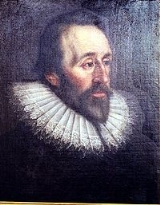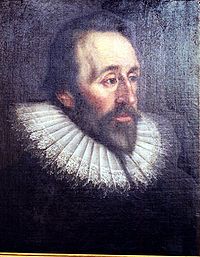
Francis Manners, 6th Earl of Rutland
Encyclopedia

Order of the Garter
The Most Noble Order of the Garter, founded in 1348, is the highest order of chivalry, or knighthood, existing in England. The order is dedicated to the image and arms of St...
(1578 – 1632) was an English
England
England is a country that is part of the United Kingdom. It shares land borders with Scotland to the north and Wales to the west; the Irish Sea is to the north west, the Celtic Sea to the south west, with the North Sea to the east and the English Channel to the south separating it from continental...
nobleman. Despite a brief imprisonment for his involvement in the Essex Rebellion of 1601, he became prominent at the court of James I
James I of England
James VI and I was King of Scots as James VI from 24 July 1567 and King of England and Ireland as James I from the union of the English and Scottish crowns on 24 March 1603...
. He lived at Belvoir Castle
Belvoir Castle
Belvoir Castle is a stately home in the English county of Leicestershire, overlooking the Vale of Belvoir . It is a Grade I listed building....
in Lincolnshire
Lincolnshire
Lincolnshire is a county in the east of England. It borders Norfolk to the south east, Cambridgeshire to the south, Rutland to the south west, Leicestershire and Nottinghamshire to the west, South Yorkshire to the north west, and the East Riding of Yorkshire to the north. It also borders...
. In 1618, three women, the "Witches of Belvoir
Witches of Belvoir
The Witches of Belvoir were three women, a mother and her two daughters, accused of witchcraft in England around 1619. The mother, Joan Flower, died while in prison, and the two daughters, Margaret and Philippa, were hanged at Lincoln....
", who worked at his castle were executed for witchcraft
Witchcraft
Witchcraft, in historical, anthropological, religious, and mythological contexts, is the alleged use of supernatural or magical powers. A witch is a practitioner of witchcraft...
, having supposedly caused the premature deaths of his sons.
Life
Francis Manners was the second son of John Manners, 4th Earl of RutlandJohn Manners, 4th Earl of Rutland
John Manners, 4th Earl of Rutland was the son of Henry Manners, 2nd Earl of Rutland and Lady Margaret Neville.He married Elizabeth Charlton, daughter of Francis Charlton of Apley Castle they had ten children:...
and his wife Elizabeth Charlton. He was a younger brother of Roger Manners, 5th Earl of Rutland
Roger Manners, 5th Earl of Rutland
Roger Manners, 5th Earl of Rutland was the son of John Manners, 4th Earl of Rutland.He married Elizabeth Sidney , on 5 March 1599....
and older brother of George Manners, 7th Earl of Rutland
George Manners, 7th Earl of Rutland
George Manners, 7th Earl of Rutland was an English nobleman. He was the son of John Manners, 4th Earl of Rutland and the younger brother of Roger Manners, 5th Earl of Rutland and Francis Manners, 6th Earl of Rutland. George Manners married Frances Cary, daughter of Sir Edward Cary and Katherine...
.
In 1598 he went abroad, traveling through France, Germany, and Italy, probably in the company of the former school teacher Robert Dalllington and Inigo Jones. On his return to England. he took part, along with his brothers Roger and George, in the 1601 rebellion of Robert Devereux, 2nd Earl of Essex
Robert Devereux, 2nd Earl of Essex
Robert Devereux, 2nd Earl of Essex, KG was an English nobleman and a favourite of Elizabeth I. Politically ambitious, and a committed general, he was placed under house arrest following a poor campaign in Ireland during the Nine Years' War in 1599...
, and was imprisoned in the Poultry Counter
Poultry Compter
The Poultry Compter was a small compter or prison run by a Sheriff in the City of London from medieval times until 1815...
. He was fined a thousand marks and committed to the custody of his uncle Roger at Enfield. Sir
Robert Cecil
Robert Cecil, 1st Earl of Salisbury
Robert Cecil, 1st Earl of Salisbury, KG, PC was an English administrator and politician.-Life:He was the son of William Cecil, 1st Baron Burghley and Mildred Cooke...
, however, obtained a remission of the fine, and thus the affair cost little either to him or his brother George. As soon. as he
was free he wrote a penitent letter to his uncle Sir John Manners of Haddon. In November 1601 he became a member of the Inner Temple
Inner Temple
The Honourable Society of the Inner Temple, commonly known as Inner Temple, is one of the four Inns of Court in London. To be called to the Bar and practise as a barrister in England and Wales, an individual must belong to one of these Inns...
.
On 28 June 1603 Francis Manners travelled with his brother to Denmark to present the Order of the Garter to Christian IV, accompanied by 'picture maker' Inigo Jones among others. He was prominent at the court of James I
James I of England
James VI and I was King of Scots as James VI from 24 July 1567 and King of England and Ireland as James I from the union of the English and Scottish crowns on 24 March 1603...
, and was created a Knight of the Bath
Order of the Bath
The Most Honourable Order of the Bath is a British order of chivalry founded by George I on 18 May 1725. The name derives from the elaborate mediæval ceremony for creating a knight, which involved bathing as one of its elements. The knights so created were known as Knights of the Bath...
on 4 January 1605 at the same time as Prince Charles
Charles I of England
Charles I was King of England, King of Scotland, and King of Ireland from 27 March 1625 until his execution in 1649. Charles engaged in a struggle for power with the Parliament of England, attempting to obtain royal revenue whilst Parliament sought to curb his Royal prerogative which Charles...
. On 26 June 1612 he succeeded his brother Roger as sixth earl of Rutland, and was made lord-lieutenant of Lincolnshire on 15 July of that year. On 7 August he entertained James I at Belvoir, and the king repeated the visit five times in after years. He held the offices of constable of Nottingham Castle
Nottingham Castle
Nottingham Castle is a castle in Nottingham, England. It is located in a commanding position on a natural promontory known as "'Castle Rock'", with cliffs high to the south and west. In the Middle Ages it was a major royal fortress and occasional royal residence...
and keeper of Sherwood Forest
Sherwood Forest
Sherwood Forest is a Royal Forest in Nottinghamshire, England, that is famous through its historical association with the legend of Robin Hood. Continuously forested since the end of the Ice Age, Sherwood Forest National Nature Reserve today encompasses 423 hectares surrounding the village of...
from October 1612 until April 1620, and carried the target or shield in the funeral procession of Henry Frederick, Prince of Wales
Henry Frederick, Prince of Wales
Henry Frederick Stuart, Prince of Wales was the elder son of King James I & VI and Anne of Denmark. His name derives from his grandfathers: Henry Stuart, Lord Darnley and Frederick II of Denmark. Prince Henry was widely seen as a bright and promising heir to his father's throne...
.
Manners was made a Knight of the Garter
Order of the Garter
The Most Noble Order of the Garter, founded in 1348, is the highest order of chivalry, or knighthood, existing in England. The order is dedicated to the image and arms of St...
on 24 April 1616. On 6 April 1617 Manners became a member of the Privy Council and accompanied the king into Scotland the same year.
The title of Lord Ros or Roos had been carried by Elizabeth Cecil, 16th Baroness de Ros
Elizabeth Cecil, 16th Baroness de Ros
Lady Elizabeth Manners, 16th Baroness de Ros of Helmsley was the daughter and heir of Edward Manners, 3rd Earl of Rutland...
, a daughter of the third Earl of Rutland, into the Cecil family, but Rutland claimed it on the death of William Cecil, 17th Baron de Ros
William Cecil, 17th Baron de Ros
William Cecil, 17th Baron de Ros of Helmsley .He was born at Newark Castle, Nottinghamshire, and baptised on 4 June 1590. In 1591, he inherited the barony of de Ros from his mother, Elizabeth Cecil, 16th Baroness de Ros. On 13 February 1615, he married Ann Lake.He was sent by King James I on a...
in 1618. He was created warden and chief justice of the royal forests north of the Trent on 13 November 1619, and custos rotulorum
Custos rotulorum
Custos rotulorum is the keeper of an English county's records and, by virtue of that office, the highest civil officer in the county...
for Northamptonshire on 7 February 1623. Although he seems to have disapproved an extreme policy in church matters, his family connection with his son-in-law, George Villiers, 1st Duke of Buckingham
George Villiers, 1st Duke of Buckingham
George Villiers, 1st Duke of Buckingham KG was the favourite, claimed by some to be the lover, of King James I of England. Despite a very patchy political and military record, he remained at the height of royal favour for the first two years of the reign of Charles I, until he was assassinated...
secured him the appointment, on 21 April 1623, of admiral of the fleet to bring home Prince Charles from Spain.
At the coronation of Charles he bore the rod with the dove. He died on 17 December 1632
at an inn in Bishops Stortford, Hertfordshire. He was buried at Bottesford.
Marriages and children
He married twice: first, in 1604 to Frances, a widow and the daughter of Sir Edward Knyvett. She bore him a daughter, KatherineKatherine Villiers, Duchess of Buckingham
Katherine Manners, Duchess of Buckingham, 19th Baroness de Ros of Helmsley , also known as Catherine, was the daughter and heir of the 18th Baron de Ros. She was known as the richest woman in Britain, apart from royalty...
, who became the Duchess of Buckingham. Frances died in 1608.
His second wife, Cecilia, also a widow, was the daughter of Sir John Tufton. She married the Earl in 1608 and had two sons, Henry and Francis, who both died in infancy, supposedly via witchcraft.

